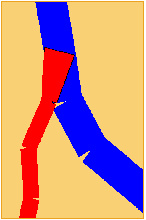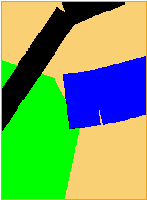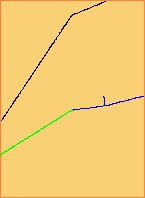|
File processing with StdSwc
(v.1.21)
General Information:
When neurons are digitally reconstructed in various labs and by different operators, the resulting
morphologies come in diverse formats and often include several types of peculiarities, idiosyncrasies, and irregularities.
In order to ensure a base level of homogeneity and compatibility with available analysis, visualization, and modeling
tools, all reconstructions in NeuroMorpho.Org are converted into the common SWC format
using L-Measure.
The resulting files undergo a process of standardization using the Java software program StdSwc. StdSwc reads SWC files, fixes
some irregularities automatically, and flags other anomalous lines as potential irregularities. All fixed and flagged lines
are documented in a standardization log file. Automatically fixed lines are designated as "type A", while flagged lines are
designated as "type B1" unless they are corrected by hand in which case they are changed to "type B2". Any additional
irregularities noted by the operator, but not detected by the program, are designated as "type C". At the end of this
process, StdSwc is run once again on the standardized file to create a log of potential "remaining issues".
Irregularities:
- Tag Irregularities
There are four default segment tags in SWC:
1 soma, 2 axon, 3 dendrite (basal when apical present), and 4 apical dendrite.
Codes 5-10 signify custom tags, typically defined in the header of the swc file when used.
In general, soma (tag 1) must start the cell and can only connect to itself.
Apical and basal should only connect to same-tag segments or to soma (possible exceptions for custom tags).
Tag irregularities
(also called type irrigularities) include:
- 1.1 Non-existent tag:
- Undefined custom tag or tag of -1.
Fix: flagged as type B1 (typically corrected by hand and changed to
B2).
- 1.2 Incorrect tag change:
- Tag 1 or 4 attached to 3, etc.
Fix: If the tag changes back in the immediately following segment, the irregularity is fixed
automatically as a type A. Otherwise, it is flagged as type B1 and checked by hand for consistency in the following segments.
-
| 1.3 Incorrect type |  | - basal as apical, etc.
|
| Fix: Type C irregularity, must be checked visually. |
- Connection irregularities
Line 1 must connect to -1. Trifurcations are not allowed. Only strict binary trees are permitted. Dendrites must start
in the soma and work distally: no looping or linking to a line number that occurs after the current point.
-
| 2.1 Trifurcation |  | | | - Fix: Flagged as B1, changed to B2 when one daughter branch is re-linked to the next nearest point to the parent to create adjacent bifurcations. Re-linking is done by hand to minimize angle
disruption and avoid crossover of daughter branches if possible.
|
- 2.2 Incorrect starting link
-
Fix: Type A irregularity, line 1 link is automatically changed to -1.
- 2.3 Link to non-existent line number
-
Fix: Flagged as type B1 irregularity and fixed by hand (changed to B2). May involve reordering points.
- 2.4 Long connection
- (Segment length greater than 6 standard deviations above the average for that type of cell.)
Fix: Flagged as a type B1 irregularity, manually checked for plausibililty.
- 2.5 Short connection.
- (Two points in a branch,
which are separated by less than 0.1 µm lengths.)
Fix: Type A irregularity; Second point is automatically removed.
- 2.6 Two non-adjacent points occupying same space.
-
Fix: Flagged as a type B1 irregularity. Generally second point is removed
(and type changed to B2), but other corrections may be necessary.
-
| 2.7 "Included" side branch
|  |  |
- Small side branch not long enough to "escape" the current diameter of parent segment.
Fix: Type A irregularity; Point is automatically removed. |
| Area view | Skeletal view |
- File format irregularities
Cell must be able to work with all common programs, especially Cvapp and L-Measure.
- 3.1 Incorrect field delineator
- (Only spaces
are allowed, tabs are not) Not logged, but automatically corrected as edited swc file is rewritten by program.
- 3.2 Incorrect (end of line) EOl, or EOF (end of file) delineators
- Only DOS-kind EOL/EOFs are permitted.
Fix: Change to correct kind.
- 3.3 Outline or branching soma
-
Fix: Type C irregularity determined through visual investigation. Outline somas are reduced to line somas. Branches are removed form somas where possible.
- 3.4 Incorrect starting location
-
File must start with soma.
Fix: Flagged as a type B1 irregularity. Cell is typically
reordered to start in the soma (and type B1 changed to B2).
- Radius irregularities
-
4.1 Zero Radius-
Fix: Type A irregularity, radius is changed to that of its parent.
|
 |
- 4.2 Large radius
-
Radius greater than 4 standard deviations above the average for that cell.
Fix: Flagged as a type B1 irregularity. Adjusted by hand/changed to B2 if warranted.
- 4.3 Small Radius
-
Radius less than or equal to .05 μm.
Fix: Flagged as a type B1 irregularity. Adjusted by hand/changed to B2 if warranted.
- 4.4 Extreme taper
-
Daughter is twice (or more) as large as parent).
Fix: Flagged as a type B1 irregularity. Adjusted by hand/changed to B2 if warranted.
- 4.5 Large terminal radius
-
Radius 5 standard deviations above average for terminal segments of that cell.
Fix: Flagged as a type B1 irregularity. Adjusted by hand/changed to B2 if warranted.
|
|
|